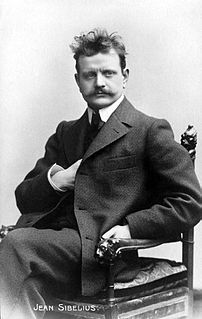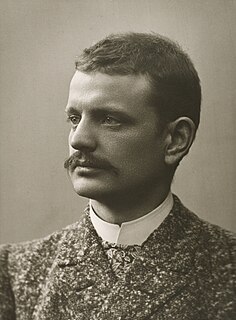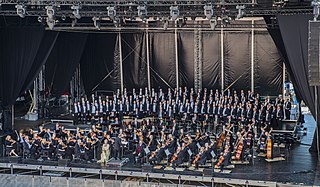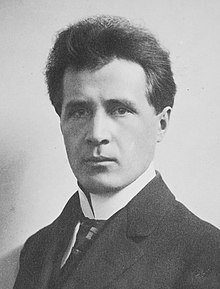
Jean Sibelius was a Finnish composer of the late Romantic and early-modern periods. He is widely regarded as his country's greatest composer, and his music is often credited with having helped Finland develop a national identity during its struggle for independence from Russia.

Leevi Antti Madetoja was a Finnish composer, music critic, conductor, and teacher of the late-Romantic and early-modern periods. He is widely recognized as one of the most significant Finnish contemporaries of Jean Sibelius, under whom he studied privately from 1908 to 1910.

Uuno (Kalervo) Klami was a Finnish composer of the modern period. He is widely recognized as one of the most significant Finnish composers to emerge from the generation that followed Jean Sibelius.

Kullervo, Op. 7, is a five-movement symphonic work for soprano, baritone, male choir, and orchestra written from 1891–1892 by the Finnish composer Jean Sibelius. Movements I, II, and IV are instrumental, whereas III and V feature sung text from Runos XXXV–VI of the Kalevala, Finland's national epic. The piece tells the story of the tragic hero Kullervo, with each movement depicting an episode from his ill-fated life: first, an introduction that establishes the psychology of the titular character; second, a haunting "lullaby with variations" that portrays his unhappy childhood; third, a dramatic dialogue between soloists and chorus in which the hero unknowingly seduces his long-lost sister; fourth, a lively scherzo in which Kullervo seeks redemption on the battlefield; and fifth, a funereal choral finale in which he returns to the spot of his incestuous crime and, guilt-ridden, takes his life by falling on his sword.

Toivo Timoteus Kuula was a Finnish composer and conductor of the late-Romantic and early-modern periods, who emerged in the wake of Jean Sibelius, under whom he studied privately from 1906 to 1908. The core of Kuula's oeuvre are his many works for voice and orchestra, in particular the Stabat mater, The Sea-Bathing Maidens (1910), Son of a Slave (1910), and The Maiden and the Boyar's Son (1912). In addition he also composed two Ostrobothnian Suites for orchestra and left an unfinished symphony at the time of his murder in 1918 in a drunken quarrel.

Robert Kajanus was a Finnish conductor, composer, and teacher. In 1882, he founded the Helsinki Orchestral Society, Finland's first professional orchestra. As a conductor, he was also a notable champion and interpreter of the music of Jean Sibelius.

The Helsinki Philharmonic Orchestra is an orchestra based in Helsinki, Finland. Founded in 1882 by Robert Kajanus, the Philharmonic Orchestra was the first permanent orchestra in the Nordic countries. Today, its primary concert venue is the Helsinki Music Centre; the current chief conductor is Susanna Mälkki, who has held her post since 2016.
An elegy is a poem of mourning.

The Ostrobothnians, Op. 45, is a verismo opera in three acts written from 1917 to 1924 by the Finnish composer Leevi Madetoja. The story, variously comedic and tragic, takes place around 1850 in the historical Finnish province of Ostrobothnia and features as its central conflict the deteriorating relationship between the farm community and its oppressive sheriff.

The Oulu Symphony Orchestra is a Finnish orchestra based in Oulu, Finland. Oulu Sinfonia gives concerts primarily at the Oulu Music Centre, in the Madetojan sali, located in the Karjasilta district, and named for Leevi Madetoja, who was born in Oulu.

The Symphony No. 1 in F major, Op. 29, is a three-movement orchestral composition by the Finnish composer Leevi Madetoja, who wrote the piece from 1914–16 at the dawn of his professional career. Although late-Romantic in style, the symphony carefully eschews the extravagance and overindulgence typical of debut efforts, placing it among the most "mature" and restrained of first symphonies. Accordingly, the First is the shortest and most concentrated of Madetoja's three essays in the form and is the only one of his symphonies not to adhere to the traditional four-movement symphonic template.

The Symphony No. 2 in E-flat major, Op. 35, is a four-movement orchestral composition by the Finnish composer Leevi Madetoja, who wrote the piece from 1916–18 immediately following the success of his First Symphony (1916). Composed during the Finnish Civil War, the Second stands as "the most significant musical document" of the conflict and finds its composer, "deeply scarred by the experience", reflecting upon national tragedy and personal loss. Accordingly, Madetoja's Second is the longest and most dramatic of his three essays in the form and, perhaps for this reason, is the most popular of the set.

The Symphony No. 3 in A major, Op. 55, is a four-movement orchestral composition by the Finnish composer Leevi Madetoja, who wrote the piece from 1925–26 while vacationing in Paris, before returning to Helsinki, Finland to complete the work. Optimistic and pastorale in character, the symphony is today considered one of the finest symphonies in the post-Sibelian, Finnish orchestral canon; indeed, a "masterpiece ... equal in stature" to Sibelius's seven essays in the form. Although technically his penultimate symphonic composition, the Third is nonetheless—due to its successor's fate—Madetoja's final addition to the repertoire.

Okon Fuoko, Op. 58, is a ballet-pantomime for orchestra, vocal soloists, and choir by the Finnish composer Leevi Madetoja, who wrote the piece from 1925–27 concurrent with the composition of his Third Symphony. The Japonisme-influenced libretto is by Danish playwright Poul Knudsen. The story takes place in ancient Japan and, similar to Coppélia, centers around the (successful) efforts of the eponymous puppet-maker to bring a female creation to life. The result is a tragic love-triangle between the seductive doll, the infatuated Okon Fuoko, and his devastated wife. With its unique and exotic musical language, Okon Fuoko is one of Madetoja's "finest" scores; indeed, the last of his "masterpieces".

Juha, Op. 74, is an verismo opera in three acts by the Finnish composer Leevi Madetoja, who wrote the piece from 1931–34. The libretto, a collaboration between Madetoja and the Finnish soprano Aino Ackté, is based on Juhani Aho's novel by the same name. The story takes place around 1880 in northern Finland, and features as its central conflict a love triangle between the farmer Juha, his young wife Marja, and a Karelian merchant, Shemeikka. Disillusioned with rural life and seduced by promises of material comfort and romance, Marja runs away with Shemeikka; Juha, who maintains his wife has been abducted, eventually discovers her betrayal and kills himself.

Aino is a single-movement symphonic poem for male choir and orchestra written in 1885 by the Finnish conductor and composer Robert Kajanus. The piece tells the tragic story of the eponymous heroine from the Kalevala, although the Finnish-language text—Ring, Kantele, Ring! —sung by the male choir at the end of the symphonic poem is not from the literary epic but rather is by an anonymous author. Aino premiered on 28 February 1885 at a concert celebrating the fiftieth anniversary of the Kalevala.

The Symphony in F minor, Op. 4, is a four-movement symphony for orchestra written from 1896 to 1897 by the precocious, 19-year old Finnish composer Ernst Mielck. The piece, reportedly inspired by Hans Christian Andersen's fairy tale the Ice Maiden, premiered in Helsinki on 20 October 1897, with Robert Kajanus conducting the Helsinki Orchestral Society. The next year, on 3 December, Mielck experienced the greatest moment of his career when the Berlin Philharmonic, one of the world's most acclaimed orchestras, played his symphony. This success, however, was short-lived, as Mielck died of consumption on 22 October 1899 while on medical leave in Locarno, Switzerland. As such, the F minor Symphony is his only contribution to the symphonic canon.

The Garden of Death, Op. 41, is a three-movement suite for solo piano written in 1918 (Movement I) and revised in 1919 by Finnish composer Leevi Madetoja. The suite, somber and mournful in character, is a tribute to the composer's brother, Yrjö, who as a captive during the Finnish Civil War was executed by the Red Guards. The Finnish pianist Elli Rängman-Björlin premiered the suite in Helsinki, Finland, on 19 March 1923, with Madetoja in attendance.

Kullervo, Op. 15, is a symphonic poem for orchestra written in 1913 by Finnish composer Leevi Madetoja. The piece premiered on 14 October 1913 with Madetoja conducting the Helsinki Philharmonic Society.













